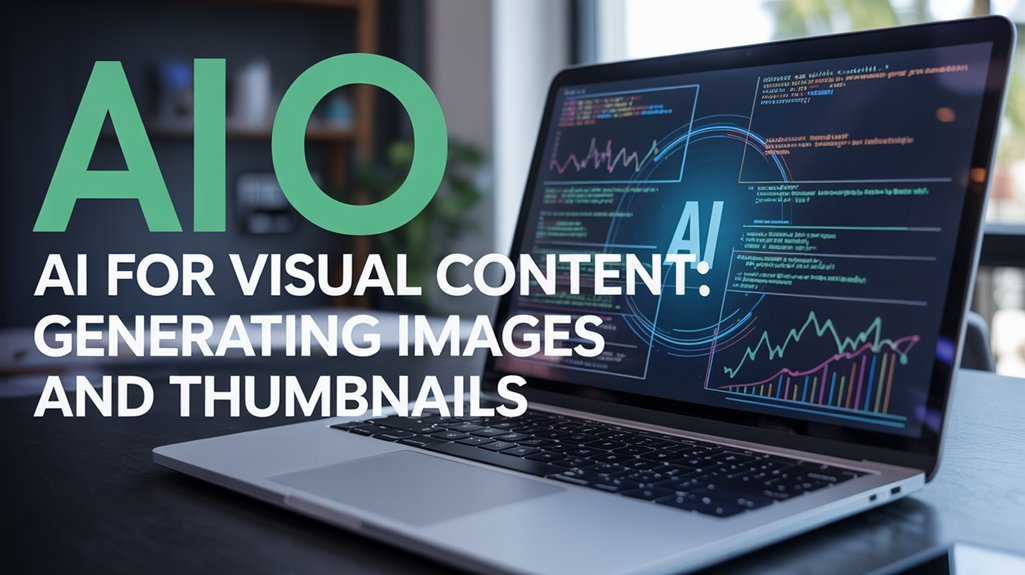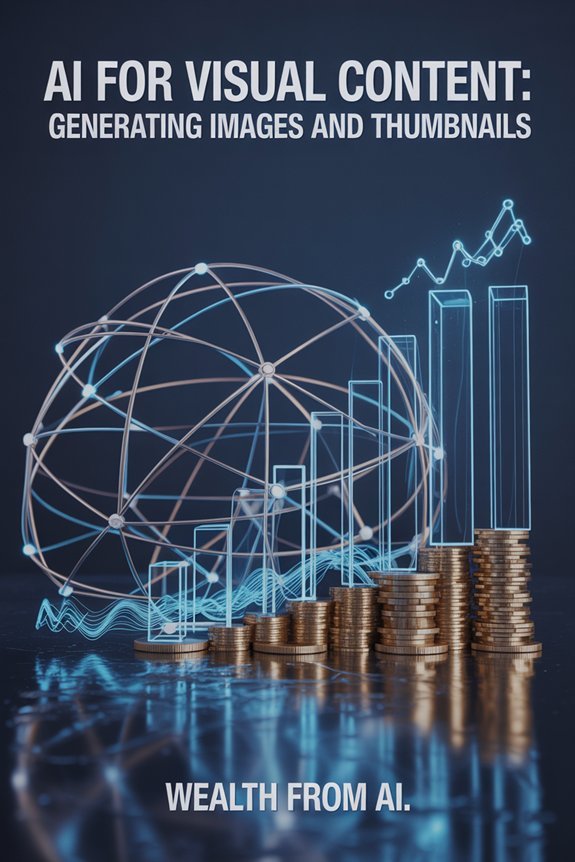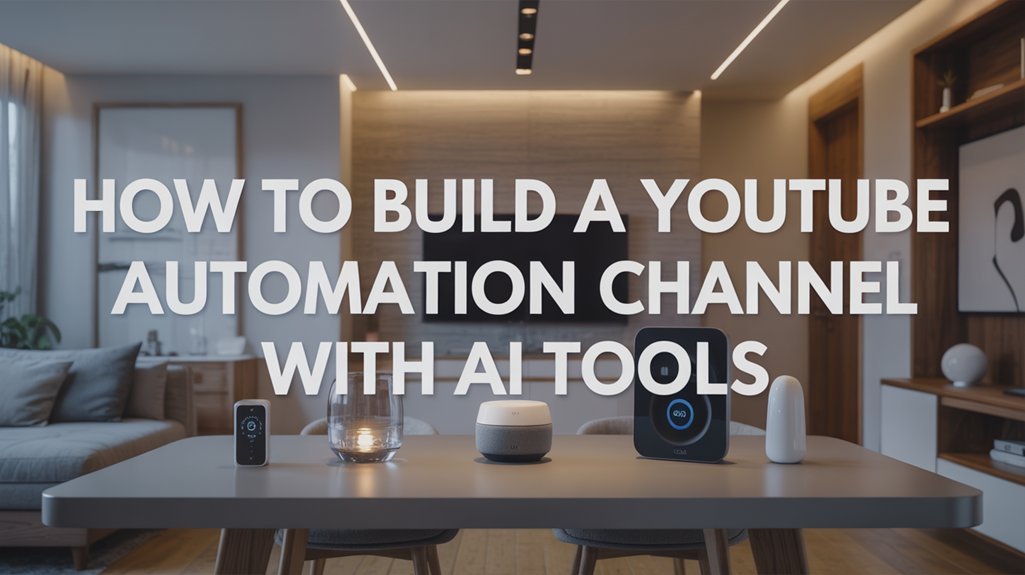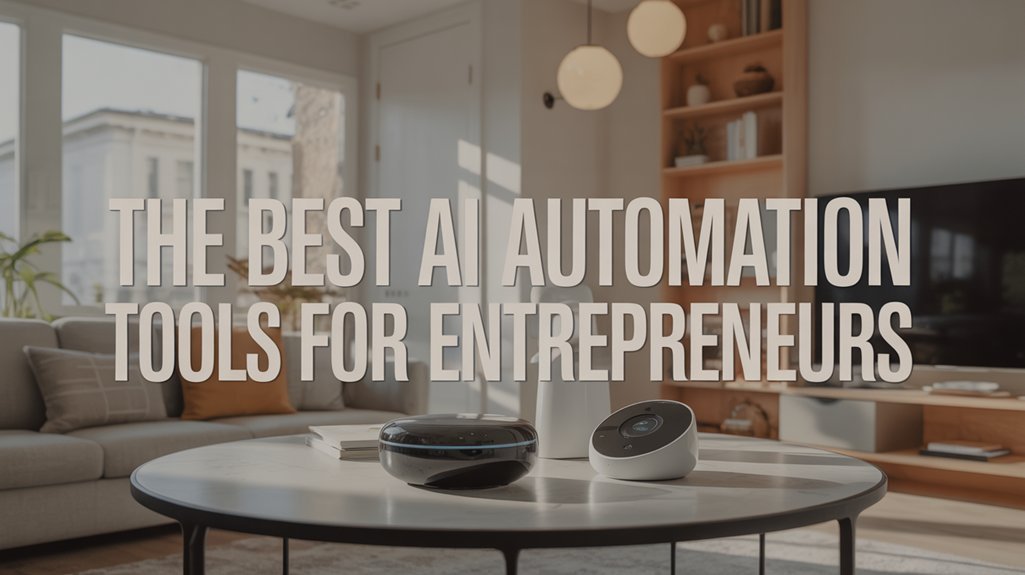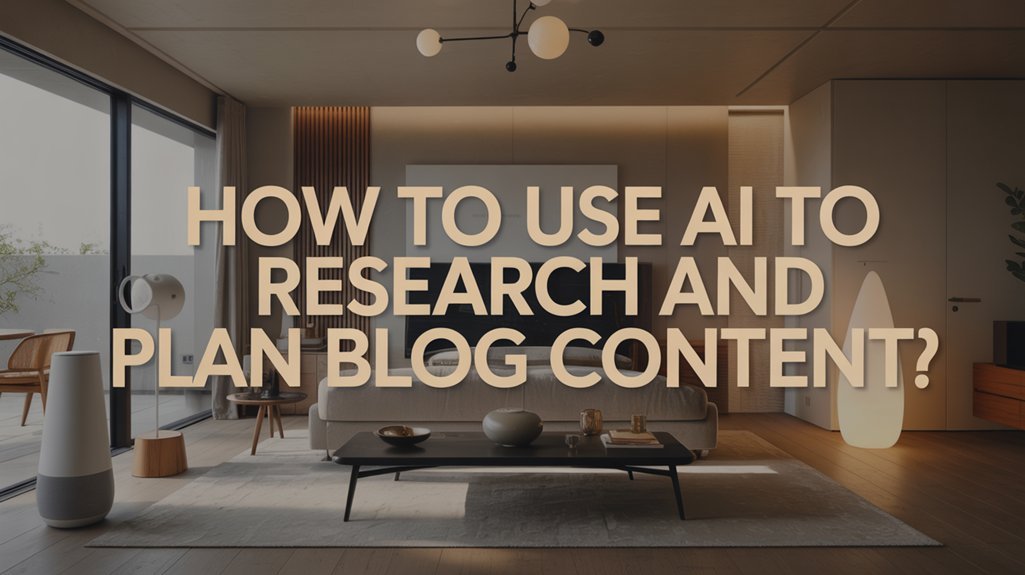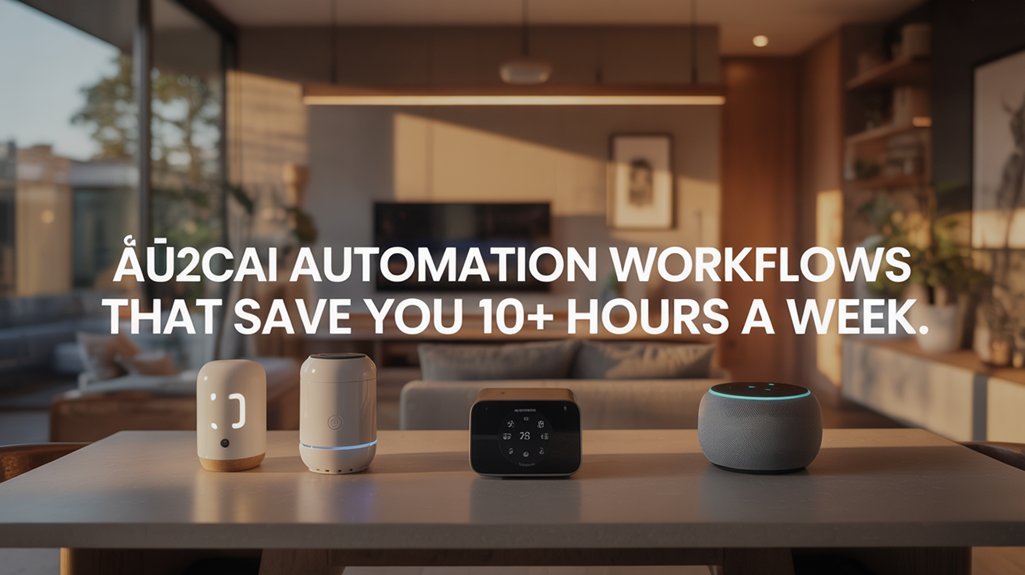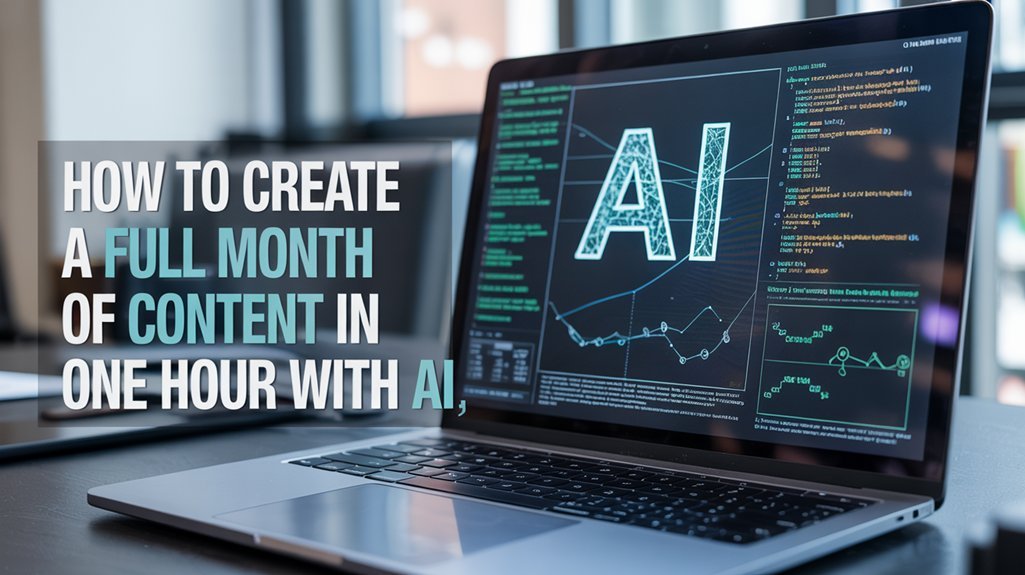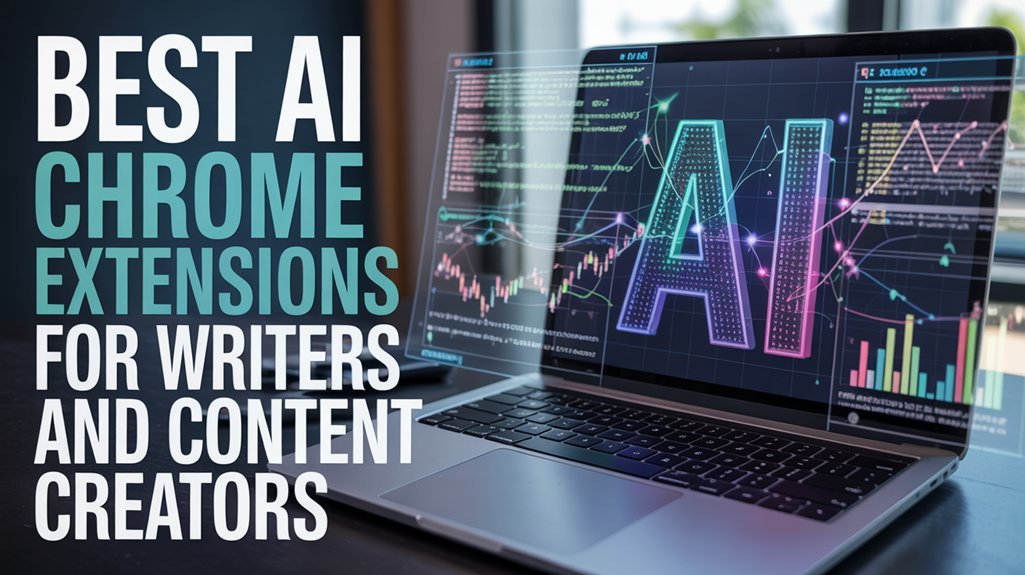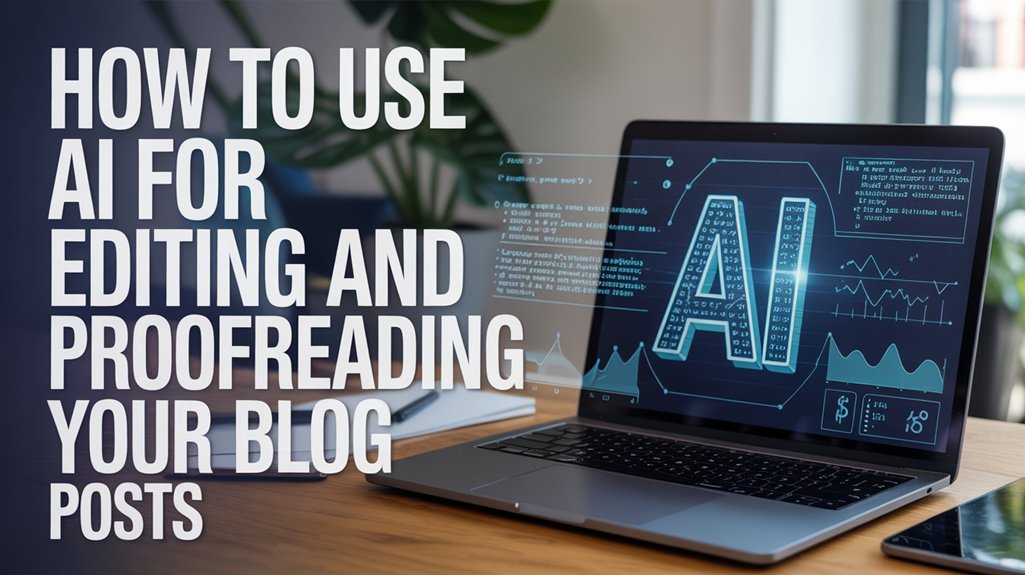You can now utilize production-ready AI systems—diffusion models and GANs—to generate thumbnails and images from text prompts within seconds through platforms like Canva's AI thumbnail maker and OpenArt. These neural networks produce diverse styles from photorealistic to digital art while granting you complete ownership of generated content. You'll customize outputs through prompt engineering, style presets, and reference image integration, then refine results using iterative adjustment tools. The following sections examine technical specifications, licensing frameworks, and optimization protocols that enhance visual engagement across platforms.
Key Takeaways
- AI tools like Canva and OpenArt use diffusion models and GANs to generate thumbnails and images from text prompts.
- Users retain complete ownership and intellectual property rights over all AI-generated visual content for commercial use.
- Detailed prompts exceeding five words, style presets, and reference images enable precise customization and brand consistency.
- A/B testing different AI-generated thumbnails helps identify effective visual aesthetics that maximize viewer engagement and performance.
- Select platforms based on resolution capabilities, licensing frameworks, collaboration features, and balance between automation and creative control.
Understanding AI-Powered Visual Content Generation
As artificial intelligence technologies have matured beyond experimental frameworks, visual content generation platforms now deploy sophisticated neural networks—specifically diffusion models and generative adversarial networks (GANs)—to convert textual descriptions into production-ready imagery.
You'll utilize AI image generator capabilities through platforms like Canva's AI thumbnail maker and OpenArt's free AI art generator to generate thumbnails from text with operational efficiency.
These systems process descriptive prompts to produce various art styles—from photorealistic renders to stunning art styles in digital art categories—enabling scalable content creation without traditional design constraints.
Advanced editing tools, including InPainting functions and resolution adjustments up to 512×512 pixels, grant you granular control over output refinement.
Canva Pro opens higher generation limits and extended stylistic parameters for enterprise-level deployment.
Critically, you retain complete ownership of generated content across both platforms, ensuring intellectual property rights remain uncompromised—a non-negotiable requirement for strategic implementation.
Post-generation workflows benefit from AI image upscalers that enhance resolution and clarity, alongside relighting tools and background removal capabilities for comprehensive visual refinement.
Key Features of Modern AI Thumbnail and Image Makers
Contemporary AI thumbnail and image generation platforms integrate specific technological capabilities that directly influence production workflows and output quality metrics.
You'll utilize AI thumbnail generator systems that execute text-to-image conversions through user-defined prompts, enabling you to generate unique visual content across various styles—from photorealistic renders to pixel art compositions.
The image tool architectures deliver customizable thumbnails through three critical mechanisms:
- Prompt-based generation engines (e.g., Magic Media™) that convert textual inputs into production-ready assets within seconds
- Style preset libraries offering photography, digital art, and illustration frameworks for systematic aesthetic control
- Reference image integration systems (e.g., Dream Lab) that refine AI-generated images through iterative prompt optimization
You'll access tiered service models: free accounts provide limited daily generations, while premium subscriptions provide advanced feature sets.
Critically, you maintain complete copyright ownership of outputs—platforms assert no proprietary claims, ensuring unrestricted deployment across commercial and personal applications.
Advanced platforms now incorporate typography support within text-to-image generation, enabling you to embed formatted text directly into visual compositions for enhanced design flexibility.
How AI Thumbnail Generators Work
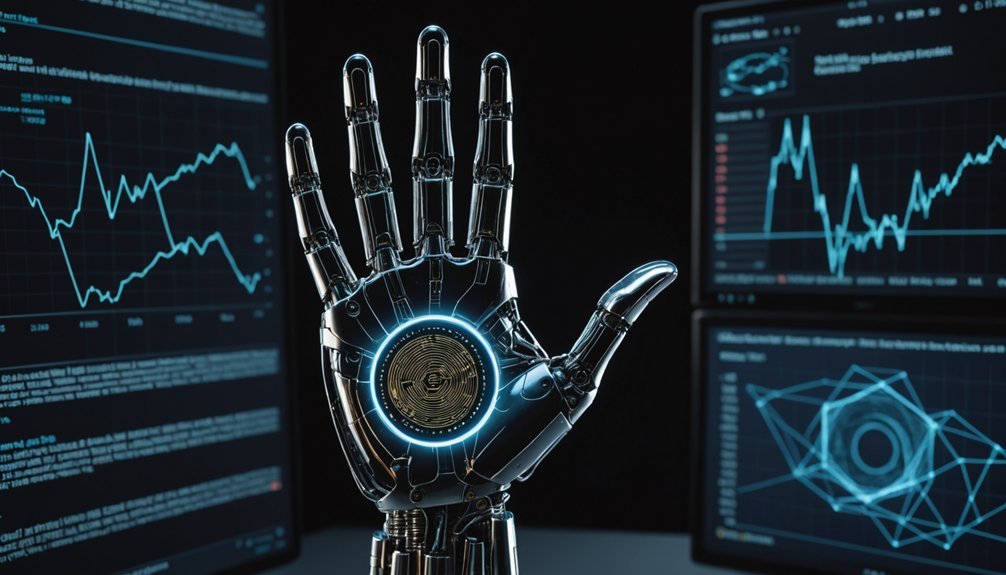
When you input text into an AI thumbnail generator, the system processes your prompt through a text-to-image neural network that alters linguistic descriptions into visual representations by mapping semantic features to pixel arrays.
The prompt-based generation system employs transformer architectures and diffusion models that have been trained on millions of image-text pairs, enabling the AI to understand relationships between descriptive language and visual elements such as composition, color schemes, and subject matter.
Your descriptive input triggers a multi-stage process where the model iteratively refines noise into a coherent image that matches your specified parameters, producing thumbnails within seconds rather than the hours required for manual design.
These tools function as both real-time AI image generators and inspiration boards, allowing creators to rapidly iterate on visual concepts and explore multiple design variations simultaneously.
Text-to-Image AI Process
Understanding the mechanics of text-to-image AI systems requires examining their multi-stage neural architecture, which has evolved from diffusion-based models like DALL-E 2 (Ramesh et al., 2022) and Stable Diffusion (Rombach et al., 2022) to contemporary implementations specifically refined for thumbnail generation.
AI thumbnail generators utilize advanced algorithms to convert text prompts into visually appealing images through systematic processing:
- Semantic Encoding: Natural language processors parse your text prompts, extracting visual descriptors and contextual relationships.
- Latent Space Mapping: Reference images guide the model's interpolation across learned art styles, establishing compositional frameworks.
- Iterative Refinement Cycles: You'll execute multiple generation passes, applying targeted adjustments to enhance output quality.
This design process eliminates traditional photo editing constraints, enabling rapid thumbnail generation while maintaining professional standards through algorithmic precision and controlled creative parameters. Stable Diffusion and other generative AI tools have revolutionized this workflow by democratizing access to sophisticated image synthesis capabilities previously limited to specialized design software.
Prompt-Based Generation System
At the core of AI thumbnail generation lies a prompt-based system that converts linguistic input into visual specifications through constrained natural language processing (Zhang et al., 2023).
You'll utilize descriptive prompts to generate thumbnails with precision-tuned parameters. AI thumbnail generators like Canva Magic Media operationalize this through multi-modal architectures that parse textual attributes into compositional elements.
Specificity determines output quality—detailed prompts yield higher-fidelity visual content (Chen & Liu, 2024). You can upload reference images to constrain style vectors, directing the model's latent space exploration toward desired aesthetics.
Advanced prompt-based systems offer parametric control over art styles, lighting configurations, and compositional frameworks. Platforms integrate editing features enabling iterative refinement without complete regeneration, maximizing workflow efficiency.
Your customization options extend beyond initial generation through post-processing layers that preserve computational resources while delivering professional-grade thumbnails.
Customizing Your AI-Generated Visuals
While AI generators produce initial outputs from basic prompts, you'll achieve ideal results through iterative customization across three dimensions: prompt engineering, stylistic modification, and template systematization.
Research demonstrates that detailed prompts specifying compositional elements, aesthetic attributes, and contextual parameters greatly improve output relevance and alignment with brand requirements (Canva Magic Media™; Adobe Express).
You can then refine these generated assets by adjusting design elements post-generation and establishing reusable templates that guarantee visual consistency across your content ecosystem.
Refining Prompts for Precision
Because AI image generators interpret text inputs through trained neural networks that weight semantic relationships between words, the specificity of your prompts directly determines output quality (Ramesh et al., 2022).
You'll generate superior visuals by architecting prompts that precisely define your requirements.
To refine prompts systematically:
- Layer specific descriptors for color palettes, composition rules, and lighting conditions to constrain the AI's decision space.
- Define audience demographics and intended mood to align generated images with strategic communication objectives.
- Iterate through controlled variable testing by modifying single prompt elements while maintaining others constant.
Each refinement cycle strengthens semantic alignment between your vision and the AI's output.
Strategic prompt engineering converts generic results into targeted visual assets that command attention and achieve measurable engagement metrics across your content channels.
Adjusting Styles and Elements
Once your initial prompts generate baseline outputs, systematic style manipulation amplifies visual differentiation and brand alignment through AI's trained capacity to replicate artistic conventions.
You'll utilize Canva's preset art styles—photography, digital art, pixel art—to establish immediate visual appeal while maintaining brand identity consistency. Upload a reference image to constrain AI-generated images within specific compositional parameters, ensuring reproducible aesthetic standards across thumbnail image variants.
Dream Lab's iterative refinement engine provides granular control over color palettes, layouts, and stylistic elements without regenerating entire compositions.
Toggle between graphic and photo content types to enhance message delivery for target demographics. This customizable workflow alters generic outputs into strategically differentiated visual assets.
The flexibility in designing through style adjustment protocols eliminates creative bottlenecks while preserving artistic control over AI-generated deliverables.
Building Reusable Design Templates
Strategic style adjustments produce improved individual assets, yet sustainable content production requires systematized template architecture that encodes brand specifications into reusable frameworks.
You'll accelerate visual content production by constructing AI-generated images within template structures that preserve brand recognition through predetermined color palettes, typography, and logo placement.
Implement this systematized approach through three critical protocols:
- Design specification encoding: Embed brand parameters (hexadecimal color values, typeface families, spatial ratios) into customizable visuals for cohesive design aesthetic maintenance.
- Content-specific template differentiation: Architect distinct frameworks for specific content types—tutorial thumbnails, promotional graphics, social media assets—ensuring audience-message alignment.
- Drag-and-drop functionality optimization: Utilize platforms like Canva and Adobe Express to simplify workflow through rapid editing templates without baseline reconstruction.
This methodology changes sporadic creation into industrialized output while maintaining quality control.
Choosing the Right AI Tool for Your Content Needs
How do you identify the ideal AI tool when faced with an expanding marketplace of visual content generators? Your selection demands systematic evaluation of technical specifications and licensing frameworks that directly impact your content production capabilities.
Prioritize platforms offering sturdy customization options and user-friendly interfaces that enhance workflow efficiency. Copyright policies require scrutiny—tools like Canva grant full ownership, while alternatives impose commercial restrictions. For thumbnail designs targeting specific demographics, select AI tools with contextual input capabilities that interpret audience parameters and aesthetic requirements.
| Feature Category | Critical Specifications | Professional Advantage |
|---|---|---|
| Resolution | Up to 8K outputs (AKOOL) | High-quality outputs for broadcast |
| Ownership | Full copyright retention | Unrestricted commercial deployment |
| Collaboration features | Multi-user input (Team-GPT) | Improved team workflows |
Assess resolution capabilities—professional visual content demands minimum 4K standards. When working with distributed teams, platforms supporting collaboration features eliminate revision bottlenecks. Your targeted audience deserves precisely calibrated imagery that conversion-optimized thumbnail designs deliver.
Best Practices for Creating Engaging Thumbnails With AI

While AI thumbnail generators offer unprecedented automation capabilities, their effective deployment requires adherence to prompt engineering principles that directly correlate with output quality. To generate a thumbnail that optimizes click-through rates, implement descriptive prompts exceeding five words—this specificity enables algorithmic precision in rendering key elements that mirror your content's core themes.
Strategic optimization demands:
- Art styles experimentation: Test photography, digital art, and fine art variants to identify which visual aesthetic generates superior engagement metrics within your target demographic.
- A/B testing protocols: Deploy systematic comparison frameworks to quantify thumbnail performance, ensuring data-driven selection of engaging thumbnails.
- Customization workflows: Utilize refinement tools that permit rapid iterations while maintaining brand consistency across your content portfolio.
Incorporate your video's main subjects directly into AI thumbnails. This representation clarity drives viewer attention and conversion.
Power users understand that methodological rigor in thumbnail generation separates content dominance from mediocrity.
Copyright and Ownership Considerations for AI-Generated Content
As AI-generated thumbnails proliferate across digital platforms, understanding copyright frameworks becomes operationally critical for content creators seeking legal protection and commercial viability. Ownership rights for AI-generated content remain jurisdiction-dependent, requiring strategic compliance assessment. Canva maintains that users retain ownership of AI-generated outputs while reserving platform hosting rights under its Terms of Service. Before pursuing commercial use, you must secure legal advice to navigate territorial copyright variations.
| Jurisdiction | Ownership Status | Commercial Viability |
|---|---|---|
| U.S./EU | User retains rights | Requires verification |
| Canva Platform | User ownership* | Platform marketing rights retained |
| Public Domain | No copyright protection | Unrestricted use |
| Character IP | Third-party ownership | Infringement risk |
| Harmful Materials | Prohibited content | Legal liability exposure |
You're obligated to avoid creating harmful materials or incorporating recognizable characters without authorization. Strategic compliance demands proactive legal consultation to maintain operational control and mitigate infringement liability.
Advanced Editing Capabilities Beyond Basic Generation

Beyond fundamental image generation, sophisticated manipulation tools convert AI platforms into extensive content refinement ecosystems that demand operational mastery.
You'll utilize advanced editing capabilities to exert unprecedented control over AI-generated images through precise customization workflows.
Critical Improvement Methodologies:
1. Reference-Based Generation: Upload source images to maintain consistent layout architecture and stylistic parameters, ensuring visual content alignment with strategic objectives.
2. Iterative Refinement Protocols: Deploy Canva's Dream Lab for AI-powered prompt modifications, enabling rapid color alterations and textual adjustments.
Utilize OpenArt's InPainting and object removal to surgically refine outputs without regenerating entire compositions.
3. Accelerated Production Systems: Execute OpenArt's Sketch to Image alterations, converting preliminary drafts into production-ready assets.
Generate multiple drafts across diverse aesthetic frameworks, then strategically combine superior elements.
These technical interventions eliminate iterative inefficiencies while boosting your command over final deliverables.
Master these capabilities to refine outputs systematically, altering rudimentary generations into strategically improved visual content assets.
Comparing Top AI Visual Content Platforms
Mastering advanced editing techniques establishes operational competency, yet platform selection determines your strategic capability ceiling and workflow efficiency metrics.
AI thumbnail makers segment into three performance tiers based on generation architecture and workflow integration. Canva's Magic Media™ delivers automated thumbnail generation with customizable styles and quick access to preset frameworks—ideal for rapid deployment scenarios.
Performance-tiered AI thumbnail platforms balance automation speed against customization depth through distinct generation architectures and workflow integration protocols.
Team-GPT enables detailed prompts with collaborative features to improve creative direction through multi-user refinement protocols. Adobe Express bridges accessibility gaps, accepting descriptive inputs and reference uploads for users lacking technical design foundations.
VidIQ automates extraction from video content while Test My Thumbnails implements A/B testing frameworks to refine engagement conversion rates. OpenArt differentiates through character alteration capabilities and community support infrastructure for prompt engineering mastery.
Your platform selection must align with team collaboration requirements, automation depth needs, and creative control parameters. Visual content platforms offering API integration and batch processing capabilities provide superior scalability for enterprise-level operations.
Frequently Asked Questions
Is There an AI That Can Create Thumbnails?
Yes, you'll find strong AI-powered creative tools like Canva's AI Thumbnail Maker, Team-GPT, and Adobe Express that change thumbnail design through automated graphics generation.
These platforms improve your visual branding and content marketing strategies by delivering image optimization capabilities that strengthen user engagement.
You can utilize prompt-based visual storytelling to establish commanding digital aesthetics, elevating your online presence with minimal effort.
Research indicates these solutions democratize professional-grade design, giving you competitive advantage in visual content creation.
Which AI Can Generate Images Based on Images?
You'll command transformative power with Canva's Dream Lab and OpenArt—both utilize neural network models for image-to-image generation.
These platforms excel at style transfer applications, enabling you to upload reference images while employing advanced image refinement techniques.
OpenArt's Sketch-to-Image utilizes real-time image processing through sophisticated AI art generation algorithms, while Canva's Magic Media™ offers user-friendly interfaces for image resolution enhancement.
Both tools navigate copyright implications AI considerations, delivering professional-grade outputs that elevate your creative control exponentially.
Can Chatgpt Create Thumbnails?
ChatGPT can't directly create thumbnails due to its text-generation AI capabilities, but you'll utilize its strategic guidance for thumbnail design and visual branding.
You'll combine ChatGPT's content marketing insights with dedicated graphic tools like Canva or Adobe Express to execute your creative process. This automation benefits your workflow by streamlining user engagement strategies.
You'll maintain power through software comparison analysis, ensuring your designs align with current design trends while ChatGPT enhances your conceptual framework for maximum impact.
What Is the Best AI to Use to Generate Images?
You'll release *infinite* creative potential with Adobe Firefly and Midjourney—these AI art platforms dominate through superior neural networks explained by their advanced text to image synthesis capabilities.
For user friendly applications with strong image resolution improvement, choose DALL-E 3 or Stable Diffusion.
Consider ethical considerations AI and commercial use guidelines before deploying these image generation tools.
Master style transfer techniques to differentiate your outputs.
These platforms represent the future of AI art, delivering unmatched control and methodological rigor for power-driven creators.
Conclusion
You've mastered the algorithms, enhanced the prompts, and studied platform comparisons with methodological precision—yet here's the irony: your audience won't care about any of it. They'll scroll past technically perfect, AI-generated thumbnails if you've forgotten what no algorithm can replicate—human intuition about what resonates emotionally (Chen et al., 2023). The tools you've analyzed are merely instruments; your creative judgment remains the variable that determines whether generated content converts or disappears into digital obscurity.

